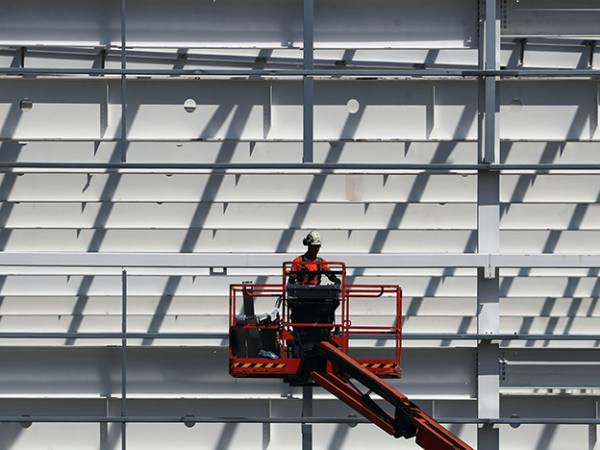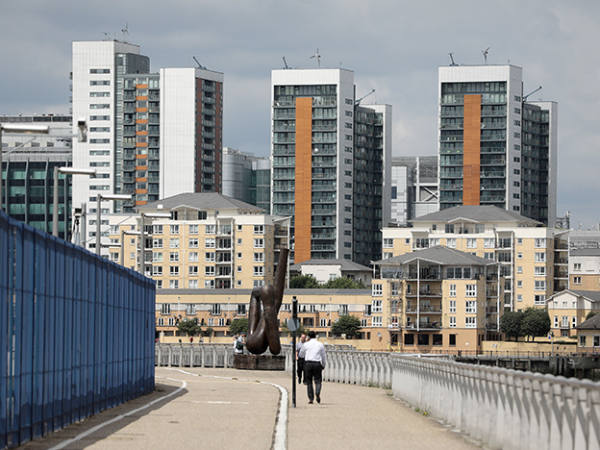In Canary Wharf, around one in every six offices is unlet. But walking around, it feels much emptier than that. Not all let buildings are occupied five days a week, and others might be empty all week as the tenants – unable to break free from a multi-year lease commitment to their landlord and who do not need to use the building – may be trying to sublet them.
Official data suggests that rents in this part of London are as high as £55 per square foot of space. But one senior London office agent, speaking anonymously, says the real cost of renting a building here, once lease incentives and rent-free periods designed to encourage tenants into the building are subtracted from the headline figure, is around £25 per square foot.
Canary Wharf is an extreme example of what happens when low vacancy causes rents to crater. But the problem is bigger and more complex than just one London business district. The question mark around workspaces post-Covid-19 combined with the threat of recession means businesses are less willing to rent space. Just as commercial real estate asset values look like they may be slowly recovering following the spike in interest rates last year, landlords must contend with the threat of vacancy dragging down their rents.
However, there is also some nuance to vacancy rates. In some sectors and some contexts, landlords might want some vacancy or might view it as an operational necessity.
So, what does this mean for real estate investment trusts (Reits)? How do their vacancy rates compare? To find out, Investors’ Chronicle crunched the numbers on the largest listed property companies to find out where they rank.
HOW REIT VACANCY RATES COMPARE | ||||||
Occupancy rate (%)* | Vacancy rate (%)* | |||||
Company | 2023 | 2022 | 2021 | 2023 | 2022 | 2021 |
LXi (LXI) | 100 | 100 | 100 | 0 | 0 | 0 |
Target Healthcare (THRL) | 100 | 100 | 100 | 0 | 0 | 0 |
Primary Health Properties (PHP) | 99.6 | 99.7 | 99.7 | 0.4 | 0.3 | 0.3 |
Supermarket Income (SUPR) | 99.6 | 99.8 | 99.6 | 0.4 | 0.2 | 0.4 |
LondonMetric (LMP) | 99.1 | 98.7 | 98.7 | 0.9 | 1.3 | 1.3 |
Unite (UTG) | 99 | 99 | 94 | 1 | 1 | 6 |
Assura (AGR) | 99 | 98.8 | 98.7 | 1 | 1.2 | 1.3 |
Grainger (GRI) | 98.5 | 97.9 | 94 | 1.5 | 2.1 | 6 |
Empiric Student Property (ESP) | 98 | 90 | 71 | 2 | 10 | 29 |
Great Portland Estates (GPE) | 97.5 | 89.2 | 86.8 | 2.5 | 10.8 | 13.2 |
Tritax Big Box (BBOX) | 96.6 | 98 | 100 | 3.4 | 2 | 0 |
Land Securities (LAND) | 95.8 | 94.9 | 95.7 | 4.2 | 5.1 | 4.3 |
UK Commercial Property (UKCM) | 95.6 | 98 | 97.9 | 4.4 | 2 | 2.1 |
Segro (SGRO) | 95.5 | 96 | 96.8 | 4.5 | 4 | 3.2 |
Derwent London (DLN) | 95.5 | 93.6 | 98.4 | 4.5 | 6.4 | 1.6 |
Hammerson (HMSO) | 94.5 | 95.2 | 94.3 | 5.5 | 4.8 | 5.7 |
British Land (BLND) | 93.7 | 93.7 | 91.7 | 6.3 | 6.3 | 8.3 |
BCPT (BCPT) | 92.8 | 94.1 | 98 | 7.2 | 5.9 | 2 |
Urban Logistics (SHED) | 92.6 | 93.1 | 93.1 | 7.4 | 6.9 | 6.9 |
Sirius Real Estate (SRE) | 83.9 | 85.3 | 87 | 16.1 | 14.7 | 13 |
Workspace (WKP) | 81.5 | 84.3 | 77.8 | 18.5 | 15.7 | 22.2 |
Big Yellow Group (BYG) | 80.9 | 83.7 | 85.2 | 19.1 | 16.3 | 14.8 |
Safestore (SAFE) | 76.7 | 82.1 | 84.5 | 23.3 | 17.9 | 15.5 |
*From most recent results for 2023 and then full-year for 2022 and 2021 | ||||||
First, the two Reits with no vacancy in their portfolios, LXi (LXI) and Target Healthcare (THRL), have a weighted average unexpired lease term of 27 years and 26.5 years, significantly higher than the average for UK Reits. Written into those multi-decade contracts is a guarantee of rental income that will increase by a set amount each year. In turn, this helps to guarantee a level of dividends for investors. It also helps to explain why there is no vacancy. After all, assuming the lease contracts are adhered to, it will be over two decades on average before either Reit will need to relet any space.
However, there are downsides to such high occupancy rates. The first issue is that the rental increases tied into the contract might not be as high as the rent they could achieve by letting the building to a new tenant. By not having any vacancies in their portfolios, landlords protect their income against a downturn in tenant demand. But they might be missing out on the potential for rent increases in a hot market.
The other issue with the long-lease, low-vacancy strategy is that it tells you nothing about the underlying security of the income. In theory, long leases guarantee rent. In practice, tenants sometimes fall behind on payments or refuse to pay. Theme park operator Merlin Entertainments and hotel brand Travelodge account for 37 per cent of LXi’s rent roll. Both have junk credit ratings from agency Moody’s, putting the bull case implied by its fully occupied portfolio and long leases into question.
Indeed, when the pandemic hit, Travelodge and LXi were at loggerheads over rent. The hotel operator’s business and rental payments have since returned to relative normality, and LXi has since returned to collecting all of its rent. However, if Travelodge faces further difficulties, LXi's income will again be at risk.
Similarly, TR Property Investment Trust’s (TRY) fund manager Marcus Phayre-Mudge says vacancy rates do not reveal how secure an office landlord’s rent roll is or how much demand there is in the market because it ignores the amount of “grey space”. This refers to the amount of space tenants on the hook for an office lease might be trying to sublet because they do not want it or cannot afford to pay for it. Phayre-Mudge notes that listed landlords are not obligated to announce how much grey space there is in their portfolio, and calculating the amount of grey space on a market level can be tricky.
Meanwhile, in the world of retail, Phayre-Mudge says “landlords will do everything that is in their power not to have dead frontage”. He says empty shop units in a shopping centre in a high street can kill footfall or the attractiveness of a retail destination, with many therefore willing to offer sizeable discounts and concessions to get the outlets occupied. In some cases, landlords may offer the space for free or on a temporary basis. All of which, Phayre-Mudge says, “gives investors completely the wrong image”.
The other side of the coin
Just as two Reits with no vacancy have very long leases, the reverse is also true. The Reits with the lowest vacancy, Workspace (WKP), Big Yellow Group (BYG), and Safestore (SAFE), are landlords whose tenants will rent space for a couple of years or perhaps even just a few months at a time. They will then give a limited amount of notice before exiting. Phayre-Mudge says there is an “embedded level of vacancy” within the flexible workspace and self-storage business models the three Reits operate in.
And where the zero vacancy Reits trade the relative security of long leases for the limited ability to increase rents, the higher vacancy Reits trade a lack of security for the ability to increase rents significantly – provided the market for their product is performing well. When the IC analysed the big Reits by increases in net rental income last month, Workspace ranked third while Big Yellow and Safestore performed above average.
However, while higher vacancy might be part of a Reit’s strategy, the consensus is that lower vacancy is generally a better thing for Reits, and a trend of increasing vacancy, even within a business model where high vacancy is part of the plan, signals falling demand. On this basis, some investors might question Safestore and Big Yellow’s steady increase in vacancies over the last three years.
Conversely, the data presents bull points for Grainger (GRI), Empiric Student Property (ESP), and Great Portland Estates (GPE), who have decreased their vacancy rates over the last three years, potentially signalling increased demand for the residential, student accommodation, and high-quality London office space that the trio offer. The real trick is turning that demand into increased earnings, though.











